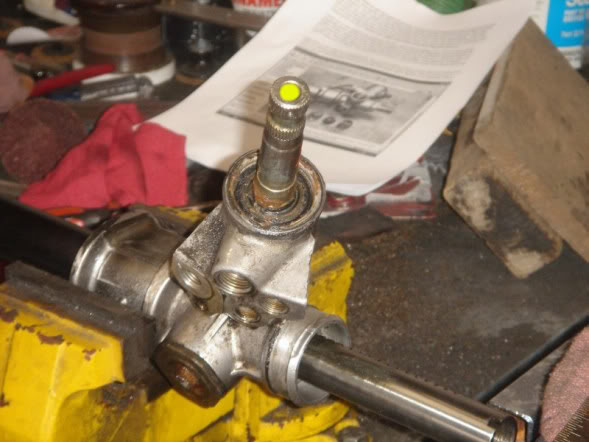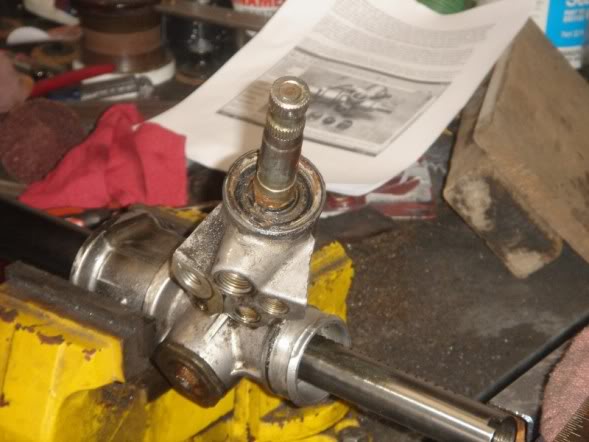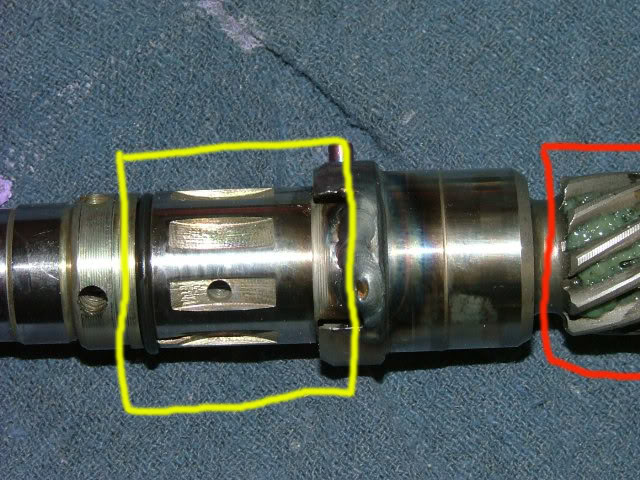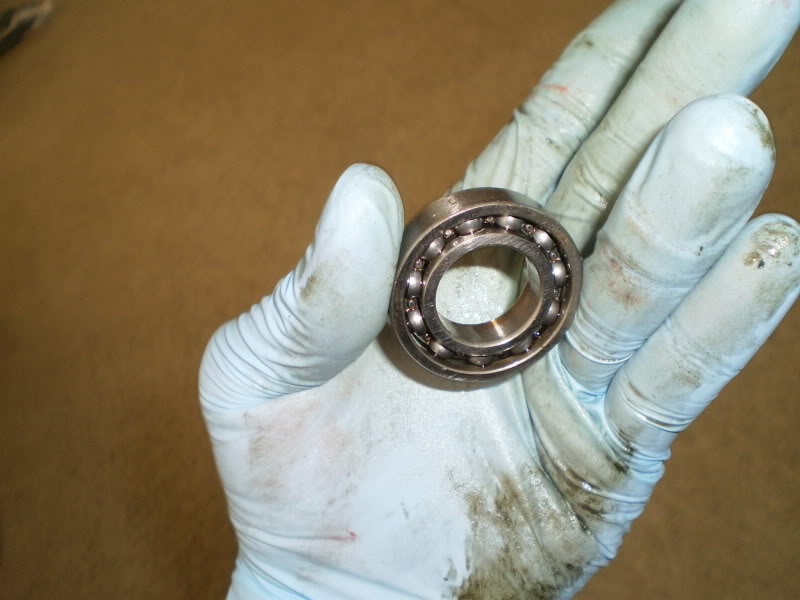Help: proper way to remove power steering
#27
Ok...so you're talking about t-bar the quill then? That must be welded, no ifs, ands, or butts. To your point, yes, I agree that w/o welding, you're stressing a part that should never see that kind of load. But by welding what is essentially two pieces together, you're significantly reducing/eliminating that load.
You are right that by welding the two parts together you are eliminating the torsion bar (which is just a torsional spring designed to give resistance).
The torsion bar is a part that you can't see via the pictures in this thread. In Yellow is the top of the torsion bar:

Non-shopped image:

The other end is (or should be) press-fit into the pinion.
The portion that is boxed in yellow is part of the PS valve, while the part in the red box is the pinion.

Whitey85mtu's view was discussed in the writeup thread I linked in my earlier post. While it's definitely a valid theory engineering wise, the real world data doesn't support it. I've never even heard of an at-home manual conversion or a Maval converted rack failing and these things have been hitting the track and streets for years.
https://www.rx7club.com/3rd-generation-specific-1993-2002-16/fd-power-steering-full-manual-conversion-write-up-631992/#post9323333

And for those who don't want to go to the other thread and read what I wrote, here is my initial post, taken from page 2:
I'm sorry, but this is a TERRIBLE idea and, not could, but WILL eventually cause a wreck because of steering failure. I just started working with Hydraulic Power Steering for Automotive Components Holdings, LLC. I saw this writeup last night an didn't think that it was a very good idea to do it, but I had to make sure before I posted something on here without any relevant information. I asked two guys (independently) that I work with, one with 30 years of power steering expierence (R&P), and the other with 34 years (R&P and RV (recirculating ball nut, like the FB has)), and both of them said that it was a terrible idea.
First of all, a power R&P Pinion (what you guys call a "quill" *shakes head*) is only case hardened, not through hardened. The only reason why there is even a pinion in the power racks is so you have road feel. They are not designed to handle long term manual use. All of the steering comes from the hydraulic fluid pressure on either side of the piston (the part that you are cutting through and breaking off the actual rack). Once you remove the hydraulic power, it's only time before the pinion teeth shear and you've lost ALL steering.
Second of all, if you don't weld the input shaft to the pinion and rely on the torsion bar (it's a torsional spring that is pinned at the knurled end of the input shaft and pressed into the top of the pinion) to steer the car, that WILL break before the pinion has time to wear to the point where it breaks. I just finished up testing on current production t-bars, and they are designed for use in a high travel valve (+- 12 degrees, +- 2 degrees during evasive manuvers). These were breaking after 20k cycles at +- 15 degrees of travel. This may not seem like alot, but the ONLY use of the t-bar in a hydraulic setup is to actuate the valve to route fluid pressure. When you go to a manual rack, the t-bar and the pinion are both used to steer the car, and they are designed accordingly. Typical road manuvers (lane changes, low speed turning) use 1-2 degrees of t-bar deflection, and during parking manuvers you're only using 7-9 degrees of valve travel (which equates to 7-9 degrees of t-bar deflection). If you're using this setup in an auto-cross situation with manual steering, you're be easily seeing 20+ degrees of t-bar deflection. This will give you EXTREMELY short lifespans. At +-17 degrees of travel (albeit on a non-heat-treated t-bar), you're looking at between 1250 and 2250 cycles to COMPLETE (t-bar in two pieces) failure.
Third, welding the input shaft to the pinion, which is safer than using the t-bar to steer the vehicle, is another terrible idea. These parts are hardened, and by inducing uncontrolled, mass amounts of heat (which is needed to weld something that thick solidly) will destroy the heat treatment around that area. This will give you two extremely weak points (one on either side of the weld) that could contribute to steering failure.
Now onto other things that you've done to mess with a steering rack. The "retainer" or whatever you called the part between the "nut" and the spring. That is known as the yoke. This part's function is to counteract the gear separation force between the pinion and the rack. It is precisely set to a certain clearance to keep friction to a minimum, while keeping the pinion and rack teeth in contact and still allowing grease to lubricate the rack to yoke interface. If you wrench this down all the way, you will increase effort substantially, induce un-needed friction, and cause the yoke to suffer excessive wear. Also, by increasing rack friction, you're either causing the t-bar to load up more, which, once again, substantially reduces the part's life, or adding alot more stress on the pinion teeth, which will cause them to fail even more quickly.
So, from my point of view after working for a little while with power R&P, and talking to two guys that are regarded as the geniuses of the group (the guy that has 34 years is a physics major that doesn't use a calculator to calculate contact ratio, rack speed, piston area required for a certain parking force, etc, and he designs the gears for the rack and pinion and the sector and worm for RV gears), that this is a very dangerous conversion and that anyone that values their lives, the lives of the people around them, and their car, wouldn't ever consider doing.
This is my $.02. Take it as you wish, but know that this isn't someone just spouting off, the data that i sited for the t-bars I just finished up collecting and analyzing last week, and that the sources of all the other information about the dangers of the pinion are from two guys that have a combined 64 years of expierence with R&P and RV gear steering.
First of all, a power R&P Pinion (what you guys call a "quill" *shakes head*) is only case hardened, not through hardened. The only reason why there is even a pinion in the power racks is so you have road feel. They are not designed to handle long term manual use. All of the steering comes from the hydraulic fluid pressure on either side of the piston (the part that you are cutting through and breaking off the actual rack). Once you remove the hydraulic power, it's only time before the pinion teeth shear and you've lost ALL steering.
Second of all, if you don't weld the input shaft to the pinion and rely on the torsion bar (it's a torsional spring that is pinned at the knurled end of the input shaft and pressed into the top of the pinion) to steer the car, that WILL break before the pinion has time to wear to the point where it breaks. I just finished up testing on current production t-bars, and they are designed for use in a high travel valve (+- 12 degrees, +- 2 degrees during evasive manuvers). These were breaking after 20k cycles at +- 15 degrees of travel. This may not seem like alot, but the ONLY use of the t-bar in a hydraulic setup is to actuate the valve to route fluid pressure. When you go to a manual rack, the t-bar and the pinion are both used to steer the car, and they are designed accordingly. Typical road manuvers (lane changes, low speed turning) use 1-2 degrees of t-bar deflection, and during parking manuvers you're only using 7-9 degrees of valve travel (which equates to 7-9 degrees of t-bar deflection). If you're using this setup in an auto-cross situation with manual steering, you're be easily seeing 20+ degrees of t-bar deflection. This will give you EXTREMELY short lifespans. At +-17 degrees of travel (albeit on a non-heat-treated t-bar), you're looking at between 1250 and 2250 cycles to COMPLETE (t-bar in two pieces) failure.
Third, welding the input shaft to the pinion, which is safer than using the t-bar to steer the vehicle, is another terrible idea. These parts are hardened, and by inducing uncontrolled, mass amounts of heat (which is needed to weld something that thick solidly) will destroy the heat treatment around that area. This will give you two extremely weak points (one on either side of the weld) that could contribute to steering failure.
Now onto other things that you've done to mess with a steering rack. The "retainer" or whatever you called the part between the "nut" and the spring. That is known as the yoke. This part's function is to counteract the gear separation force between the pinion and the rack. It is precisely set to a certain clearance to keep friction to a minimum, while keeping the pinion and rack teeth in contact and still allowing grease to lubricate the rack to yoke interface. If you wrench this down all the way, you will increase effort substantially, induce un-needed friction, and cause the yoke to suffer excessive wear. Also, by increasing rack friction, you're either causing the t-bar to load up more, which, once again, substantially reduces the part's life, or adding alot more stress on the pinion teeth, which will cause them to fail even more quickly.
So, from my point of view after working for a little while with power R&P, and talking to two guys that are regarded as the geniuses of the group (the guy that has 34 years is a physics major that doesn't use a calculator to calculate contact ratio, rack speed, piston area required for a certain parking force, etc, and he designs the gears for the rack and pinion and the sector and worm for RV gears), that this is a very dangerous conversion and that anyone that values their lives, the lives of the people around them, and their car, wouldn't ever consider doing.
This is my $.02. Take it as you wish, but know that this isn't someone just spouting off, the data that i sited for the t-bars I just finished up collecting and analyzing last week, and that the sources of all the other information about the dangers of the pinion are from two guys that have a combined 64 years of expierence with R&P and RV gear steering.
#28
I won't let go

Ok. I guess the proper definition of a quill is a shaft turning independently inside another, right?
So we use the term loosely since it does somewhat turn independently though is connected by said torsion bar.
What would be the better term? Pinion shaft?
So we use the term loosely since it does somewhat turn independently though is connected by said torsion bar.
What would be the better term? Pinion shaft?
#32
np, thats what the search button is for..
as far as the bearing, i dont believe so.. its been so long since i did this that i dont remember... it all works beautifuly tho!... when i go home ill check my parts bin.... im almost positive the bearing is in there..
as far as the bearing, i dont believe so.. its been so long since i did this that i dont remember... it all works beautifuly tho!... when i go home ill check my parts bin.... im almost positive the bearing is in there..
Thread
Thread Starter
Forum
Replies
Last Post
LunchboxCritter
2nd Generation Specific (1986-1992)
15
01-03-16 04:11 PM
Frisky Arab
2nd Generation Specific (1986-1992)
13
08-18-15 05:30 PM






